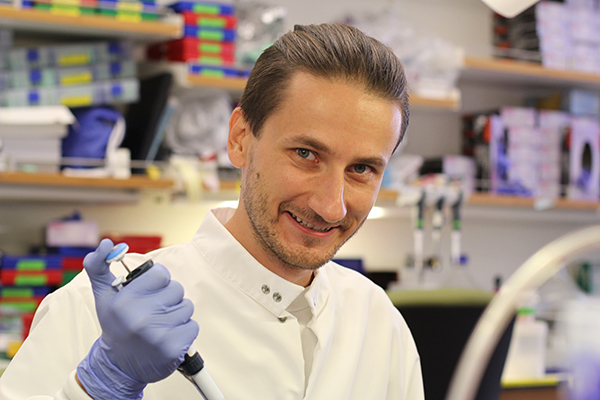
During his career as a developmental biologist, Hearst Fellow Peter Fabian has studied many kinds of fish—from bichir and sturgeon, to gar and medaka. However, his favorite is the zebrafish, the current focus of his postdoctoral training in the USC Stem Cell laboratory of Gage Crump.
“I like zebrafish most,” said Fabian. “It’s a very convenient, small fish. It’s a perfect model organism.”
By observing zebrafish embryos, Fabian is exploring how stem cells generate the cartilage, bone and tendons of the face during normal development, and how stem cell dysfunction contributes to craniofacial birth defects—which are common in newborns.
During his fellowship, Fabian will create a “map” of the different types of progenitor cells within the developing zebrafish face. He will determine which genes are active in which cell types, and then use these genes as “markers” to recognize the different cell types and follow their developmental trajectories.
Throughout the project, he will also collaborate with scientists from the USC Stem Cell lab of Michael Bonaguidi.
While Fabian never expected to spend so much time in the company of fish, he was always destined for life in the laboratory. His scientific curiosity blossomed during his early years in Slovakia—where his family lived in the small town of Spisska Stara Ves before moving to the capital city of Bratislava.
“In grammar school, I really appreciated chemistry,” he said. “Then I became fascinated by biochemistry—how the processes in the body or in the cells transform one molecule into another molecule, and how cells are able to get energy from it.”
He pursued bachelor’s and master’s degrees in biochemistry at Comenius University in Bratislava. He then obtained his PhD in developmental and molecular biology at Charles University in Prague, Czech Republic. During his PhD, he performed research in the field known as “evo-devo,” studying how developmental mechanisms underlie early vertebrate evolution in Zbynek Kozmik’s lab. They published their findings in several journals, including Developmental Genes and Evolution, Frontiers in Genetics, Developmental Biology and Scientific Reports.
During his graduate school years, Fabian also supervised undergraduates and organized student events and PhD conferences.
After graduation, he remained at Charles University for a short but productive postdoc in Robert Cerny’s lab. During his six months in the lab, he investigated facial development in three fish—tropical gar, bichir and sturgeon—and co-authored a paper in Nature.
“The advantage of sturgeon is that you have caviar,” said Fabian. “The biggest disadvantage of sturgeon is that the generation time is about 4 years.”
With this in mind, Fabian joined Crump’s highly productive zebrafish laboratory at the Eli and Edythe Broad Center for Regenerative Medicine and Stem Cell Research at USC.
“Peter impressed me right away with his enthusiasm and broad knowledge of developmental biology,” said Crump. “It was clear to me that Peter was a perfect example of the type of out-of-the-box researcher who can bring new insights into a field. I was therefore thrilled to recruit him to my lab.”
Since arriving at USC in January 2017, Fabian’s biggest challenge has been trying to moderate his intense enthusiasm for his work.
“I’m fascinated by biology and the sciences,” he said. “I would like to spend much more time here in the laboratory, but I have a family, so I need to be rational and save time for science and time for family! But if I have an experiment, I’m here all night, because it’s awesome.”
After completing his postdoctoral training, he intends to move back to Europe with his wife and two children—currently ages two and four—and start his own independent research laboratory.
“I’m so pleased and honored that I’ve received this fellowship,” said Fabian. “This is really a cornerstone that I can build my career on. It also supports me as a person and my family, and enables us to enjoy life here. So I’d really like to thank the Hearst Foundation for their support.”
